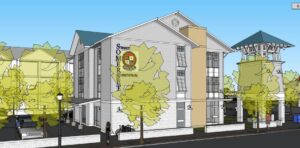
OCEAN CITY – A new design and cost estimate for a mixed-use facility on Somerset Street highlighted a presentation this week.
On Tuesday, City Manager Terry McGean presented the Mayor and Council with a new design and cost estimate for a proposed mixed-use building on Somerset Street. While he noted that construction costs have increased by roughly $2 million, the new plan would provide employee housing and a new Ocean City Police Department substation.
“We modified the design,” he said. “I think it is a much more functional and manages to actually serve more purposes.”
Nearly two years ago, the Ocean City Development Corporation (OCDC) pitched the idea of sharing the development of a mixed-use facility at the Somerset Street parking lot. The proposal initially called for a three-story building with police bicycle storage and public restrooms on the first floor and housing for seasonal employees such as police officers and public safety aides on the second and third floors.
The proposal also called for a cost-share arrangement between the town and OCDC, with the nonprofit contributing half of the funding through its share of the Inlet parking lot revenue. For years, the OCDC has received a portion of the weekend Inlet parking lot revenue as a reserve fund of sorts for projects it has, or intends to develop, in the downtown area.
“The Ocean City Development Corporation had initially committed to funding half of the cost of the building,” McGean said this week. “They remain behind that commitment that they will fund out of their Inlet lot appropriation 50% of the cost of construction of the building.”
While OCDC remains steadfast in its commitment, McGean noted that other aspects of the project have changed since the concept was first proposed.
For example, following a series of meetings with OCDC and resort staff, the decision was made to change the building’s design to incorporate a new police substation, which was identified as a priority project in the town’s 2022 Capital Improvement Plan. McGean said the police department’s existing Boardwalk substation, located above the restrooms at Worcester Street, will be converted to a special events command center.
“Right now, when we have Bikefest, Sunfest, Springfest, all the things we do at the Inlet lot …,” he said. “We think that works very well for reuse of that existing building.”
With a new substation at Somerset Street, McGean said the first two floors would feature a public lobby, restrooms, office space, an interview room and police bike storage, which would free up space at the beach patrol building. The third floor, he added, would feature 16 beds for employee housing.
“It does a number of things,” he said. “It provides good neighborhood presence for the police department downtown, it frees up storage space for the beach patrol, and it gives us a good command center to deal with special events at the Inlet parking lot.”
McGean told the council this week that Gillis Gilkerson, construction manager, had priced out the new design and the cost estimate had come in at $4.26 million, or roughly $2 million more than the initial cost estimate. He noted, however, that the increase reflected current construction costs.
“The actual estimate has grown substantially,” he said. “It has nothing to do with the change in design.”
For his part, Councilman John Gerhig questioned if manning a new substation would incur additional expense or impact deployments. Police Chief Ross Buzzuro said it would not.
“There wouldn’t be anything adverse to the overall operation,” he replied.
Gehrig also questioned the cost share arrangement between the town and OCDC. McGean said OCDC has committed to funding 100% of the design costs and 50% of construction costs.
“We would borrow the full amount, and then they would pay 50% of the debt service,” he said. “The debt service on this would be around $67,000 to $70,000 a year.”
Councilman Peter Buas noted the town’s debt service obligation would be higher than initially budgeted in the capital improvement plan. He asked how that would affect other capital projects such as the redevelopment of Baltimore Avenue.
“How is that going to affect other projects, mainly Baltimore Avenue?” he questioned. “Is this a blip, or is this something we need to think about more comprehensively?”
McGean said the change would have no impact on bond rating or debt affordability.
“To me, this is a blip when you look at what the debt service is on Baltimore Avenue …,” he replied. “In my mind, whether we do this or not, it’s not going to impact our ability to do Baltimore Avenue given the dollar differences.”
After further discussion, the council voted 6-1, with Council President Matt James opposed, to formally approve funding for the mixed-use building through a bond reimbursement resolution.
“We would come to you with a resolution that would allow us to reimburse ourselves with bonds up to a certain amount, and then we would move forward with finishing the design,” McGean explained. “We have to get the construction documents and the bid process and then ultimately you would have to then approve that number in the bond ordinance itself.”

